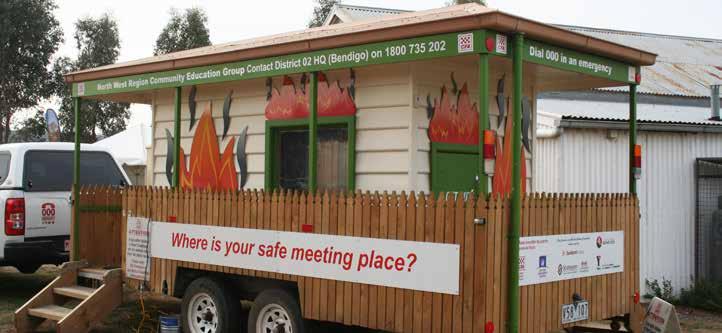
3 minute read
How CECs work with brigades
“The community engagement coordinator (CEC) role has two parts: supporting local brigades in their communities and promoting fire safety messages in the community,” Paul Tangey said. Paul has been a CEC in North West Region for more than 11 years and is also a volunteer member of the District 2 Headquarters Fire Brigade and a member of the North West Region Community Education Group – the only one of its kind in the state. “Every CEC works differently so I can only speak for the work I do, but I’ve found there are many ways to support brigades in the community, whether it’s providing resources or facilitating open days, community safety evenings or community events. “The largest part of the CEC role is planning,” Paul said. “Community safety plans are created each year which allow us to identify where brigades and communities need support.” Each CFA region has a handful of CECs responsible for a number of brigades. Paul is based in District 2 and supports 76 brigades, along with two other CECs who are based in District 14 and Districts 18 and 20. “We work closely with brigade administrative support officers (BASOs) and commanders to give members the support they need. “The CEC role gets you out and about mixing with the community,” Paul added. “Emails and reporting are part of it, but our role isn’t a nine-to-five desk job; it involves more than that. I’ve worked a lot of evenings and weekends. “Being within communities is an aspect I really enjoy. It’s great to be able to have the flexibility in the role and support volunteers when required.” Five years ago, CFA introduced the role of community safety coordinator in brigades. CECs work closely with these members and are their point of contact for the brigade. “The community safety coordinator role gives back recognition to the work brigade members are doing in that space.” Paul said part of his role is looking for new ways to engage with the community. “Fire Ready meetings don’t have to be held at brigade stations. We’ve found they are more productive when held at community events.
66
Advertisement
“We often have a presence at local community events to educate the public. This also helps build relationships so people know CFA plays an active role in the community. “There are so many benefits of having this presence. It helps familiarise us with each brigade’s location and the fire danger risks so we can educate the community on the right subjects. “We attend these events when the brigade needs assistance. However, a lot of the time my work is supplying resources such as stalls, fire safety handouts, CFA memorabilia and other things such as the Captain Koala suit.” Promoting fire safety messages is a very important part a CEC’s role. “We do a lot of work with different agencies across a number of platforms to get fire safety messages out. I have close relationships with local media and community sources such as newsletters, supplying messaging for road signs, creating social media information for brigades and even helping to craft CFA presentations. “The focus is to educate. We provide up-to-date information across a range of different topics including what the fire danger scale means, what a Code Red day means, Total Fire Bans, preparing for the summer, permits and more.” As a volunteer Paul is Secretary and Treasurer of the District 2 Headquarters brigade as well as a member of the North West Region Community Education Group This group comprises 14 CFA volunteers from different brigades who discuss fire safety and support brigades in the work they carry out in their communities. The group has attended many events to fundraise and promote fire safety messages in the community. The group has its own smoke house (pictured) that’s been renovated into a house fire simulation to educate children about what they need to do in an emergency. “Although I keep working and volunteering separate, I’m able to draw on my shared experience in both roles.”










